After having spent over a day getting from Paris to Halifax via a very indirect route, I was thrilled to have finally arrived, having just met my uncle and aunt at the airport. However, there was work to be done, and straight away: I had to recover my trusty motorcycle!
Motorcycle? What motorcycle?
Most people who find out that I am a motorcyclist are quite surprised by this fact. This does not surprise me, as I can understand how I might not fit the biggest two stereotypes of motorcyclists in the public eye:
- Sport-bikes and their riders
- Modified exhaust pipes that deafen people in the surrounding areas
- Blatant disregard for road safety and speed limits
- License plate mounted so as to be difficult to read (or missing altogether), further supporting the law-breaking image
- In Paris: riders like to block off the cycle path or sidewalks on the Pont de Bir-Hakeim to stage photoshoots, because apparently an important reason for owning a motorcycle is to annoy people while taking pictures of it.
- Often, couldn’t care less about the environment
- Harley-Davidson riders
- Modified exhaust pipes that deafen people in the surrounding areas (this seems to be a common motorcycle trait)
- “Macho” image, moustache, leather jackets
- Often riding to or from bars… because, apparently, riding a motorcycle after consuming alcohol seems like a good idea
- Bikes often covered in politically conservative stickers
- Almost always, couldn’t care less about the environment
For me, a motorcycle is a way to explore the countryside and nature, and to travel relatively inexpensively (though with fuel prices rising, this is not as much the case as it was when I started riding). Because I have little in common with the vast majority of motorcyclists, especially those who correspond to the stereotypes mentioned above, motorcycling has almost never been a group activity for me, as I have met only a few riders with whom I enjoyed travelling. Despite a lack of company, I have been fortunate to have been able to explore large parts of Canada, the United States, and Europe by motorcycle.
I have owned a total of five motorcycles in my life, with just one remaining: a 2000 Kawasaki Concours, which I bought as a student in Alberta in the summer of 2015, and on which I have ridden over 80,000 kilometres. Over the years, although I have dealt with small mechanical or electrical issues related to its high mileage, this motorcycle has been very reliable, and is inexpensive to operate.
When I moved to France, I considered selling the motorcycle, but the price would have been quite low, so I decided to keep it available for when I spend time in Canada. As such, for the last few years, the motorcycle has lived with my parents, being occasionally used by my father, and otherwise just taking up space in the garage, waiting to be ridden.
Now, let’s return back to the arrival in Halifax and the summer trip: My parents had lived in Halifax for several years, but a few weeks prior to my arrival, they moved back to our province of origin, Ontario. However, as I wished to ride the motorcycle from Halifax back to Ontario, they left the bike in a rented storage container in Halifax.
My uncle and aunt took me to the U-Haul storage facility from the airport, where the manager had kindly accepted to keep the keys of the storage unit in her office until my arrival. After having retrieved the keys to the storage unit, my uncle and I were able to move the bike outside, gather all my supplies, and make sure the bike started up. Then, I hopped on it, and started making my way to the lovely little town of Lunenberg, Nova Scotia, where I would stay for a few days with my uncle and aunt.
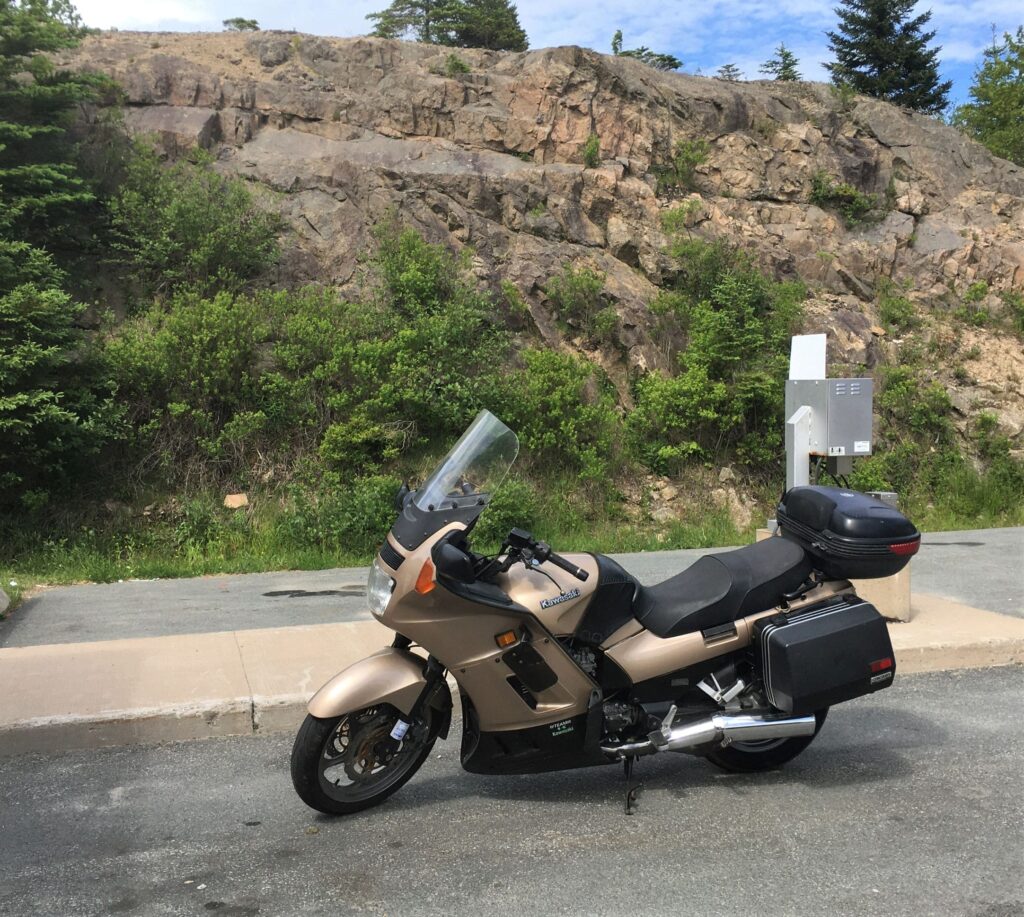
The morning after my arrival, my uncle and aunt took me to see some dory racing! A dory is a small boat that was traditionally used for fishing in New England and Atlantic Canada, but is now mostly used for recreational purposes. What I witnessed was an elimination round, organised by the Canadian Dory Racing Association. The winners would go on to compete in the International Dory Races in Massachusetts. Despite the small size of Lunenberg, the crowd was surprisingly large on this beautiful Saturday morning, and very enthusiastic!
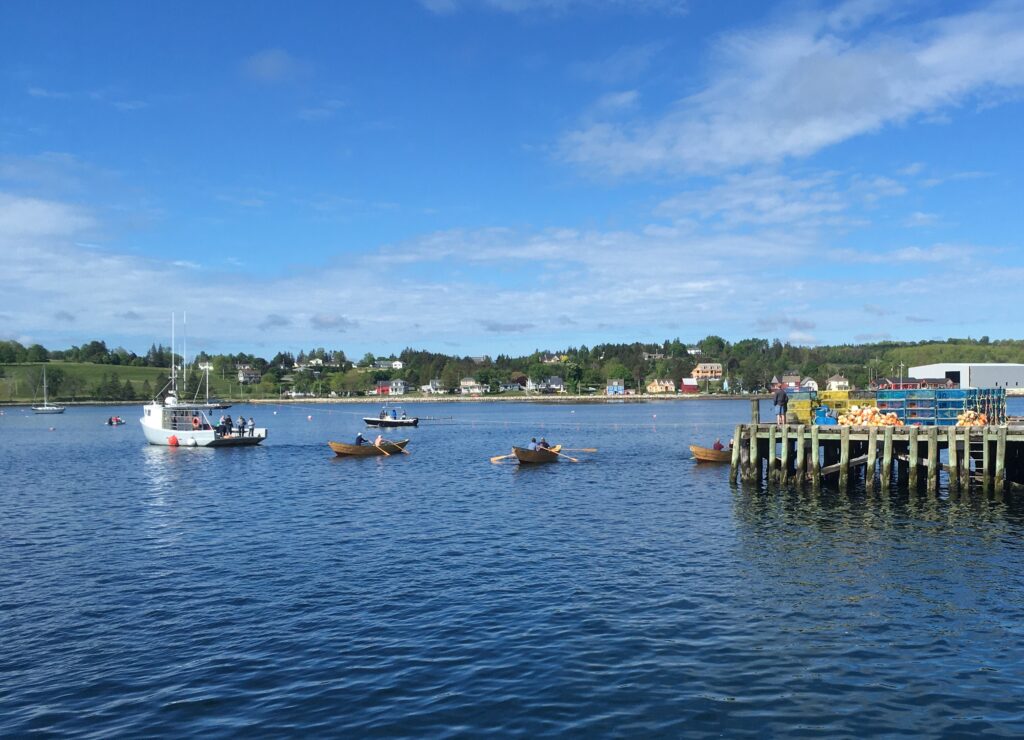
The rest of the weekend was spent peacefully relaxing in the Lunenberg area, wandering around the town, and doing a bit of motorised exploration.
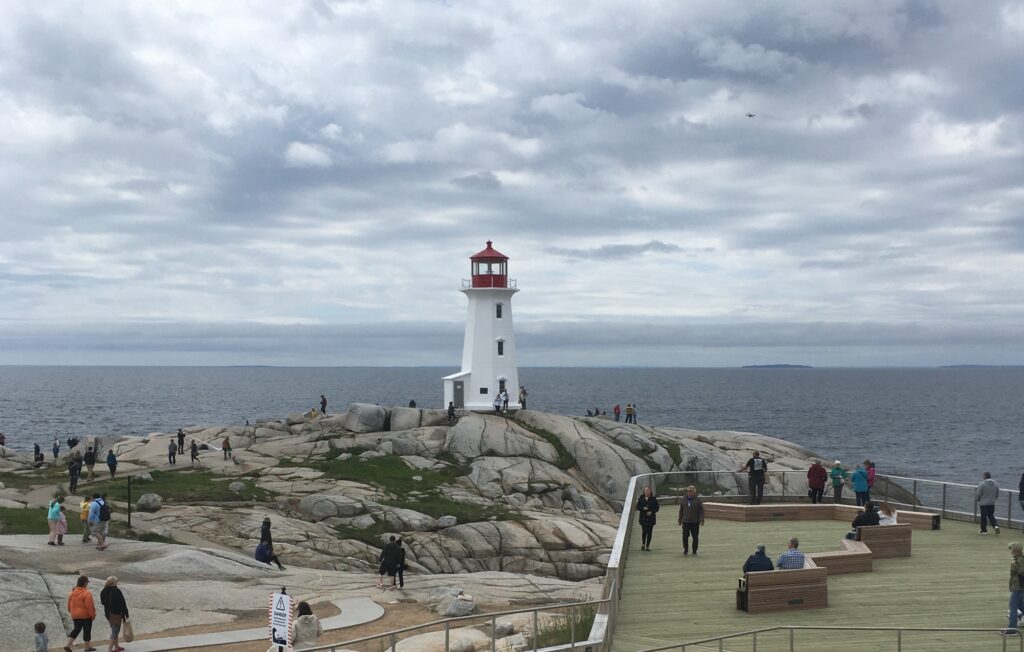
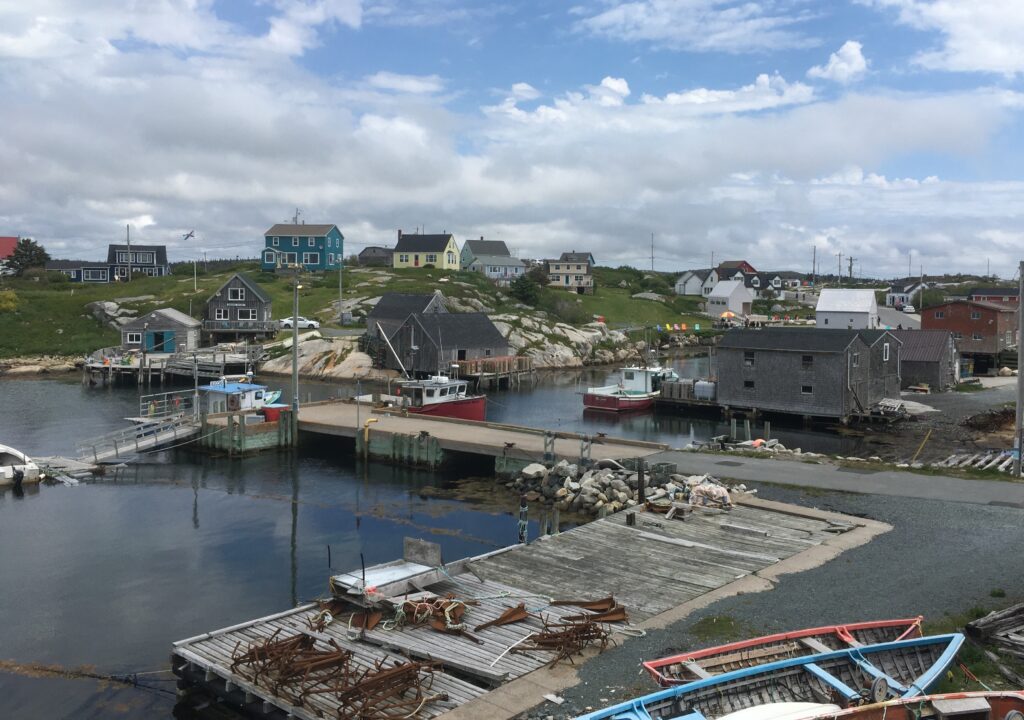
Nova Scotia is a beautiful province, and although the weather is still chilly in early June, it is nonetheless a great time to visit. However, my plans for the summer required me to advance towards the west, and after spending the weekend with my uncle and aunt, I did just that.
Visiting Saint John, New Brunswick
At the time of this trip, I had not seen my brother, who lives in Saint John, New Brunswick, in about two years. The impending trip westward from Nova Scotia, which would take me into New Brunswick, seemed like a good opportunity to visit and reconnect! Saint John is not terribly far from Halifax, with the trip taking four hours when driving, or a little longer when taking a ferry from Digby, Nova Scotia directly to Saint John (a much more pleasant but also more expensive route). Although I preferred the ferry, which allowed for relaxing and enjoying the sights of the ocean, I simply could not justify the extra cost of the ticket. So, on Monday, I left Halifax and drove for four hours, reaching Saint John in time to purchase food and make myself dinner. (I was not eating alone, but sharing a meal becomes complicated when one is vegan and those around him wish to eat meat.)
I had been to Saint John only a couple of times before this visit, for very short periods. Although it was for a long time the most populous city in New Brunswick (a title that is now possessed by the bilingual city of Moncton), it is not large by most peoples’ standards, with a population of about 70,000. It sits on the Atlantic coast in the Bay of Fundy (a bay between the provinces of New Brunswick and Nova Scotia), and is one of Canada’s most important shipping ports. Like most cities of its size, it has plenty of large-format grocery stores, a few shopping centres, and other standard amenities in the suburbs, with a small, walkable downtown that provides nice pubs, restaurants, and other shops that one might expect to find. Unfortunately, like most North American cities, the suburbs are not very pleasant to walk around it, but where my brother lives in a good location from which one can easily access the downtown area by foot.
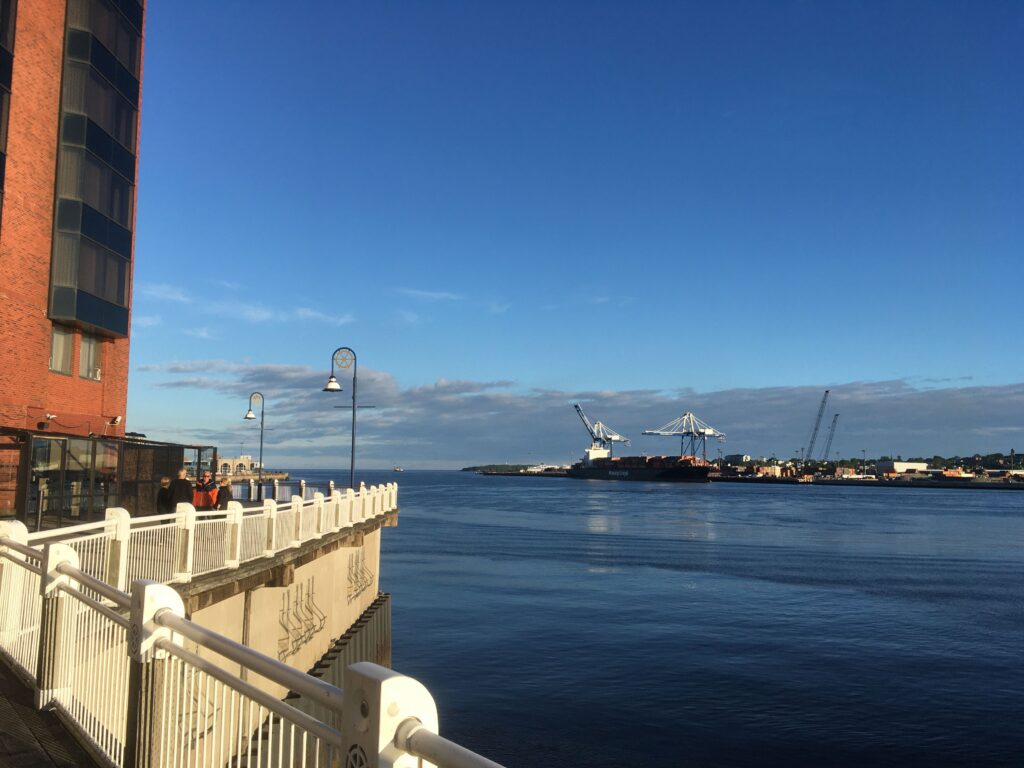
My brother and his then-fiancée were working their normal schedules, as was I, so a good portion of my time in Saint John was spent in their house on my own, working remotely. We were able to spend some time together when not working, by seeing a film on one occasion (Top Gun: Maverick, to be precise), having dinner, or going for a drink downtown. However, after four days, my scheduled required me to move on: I was going to travel from Saint John to Ontario (the province, not one of the cities in California or Oregon), and this trip would be best accomplished in a short burst on a weekend, to avoid having to interrupt the trip with the half-days of remote work that occupied my weekdays. So, after completing my morning half-day of work on Friday, I bid farewell to Saint John and started travelling again.
A short jaunt through New England
In the past, I had travelled between Saint John and Ontario by remaining in Canada and driving through the province of Québec:

However, this trip seemed like an ideal time to visit a new part of the United States that I had never visited before, the upper part of the New England region. Based on the itinerary that I had planned out, I would travel through Maine, a little bit of New Hampshire, Vermont, and New York, before finally entering Ontario near Niagara Falls. However, this ended up seeming a lot less simple than it should have been, because in many of the places along the way, especially northeastern New York, there weren’t many simple east-west highways apart from large Interstate highways (which did not interest me), so I ended up entering Canada near the city of Cornwall, Ontario. My final route ended up looking like this:
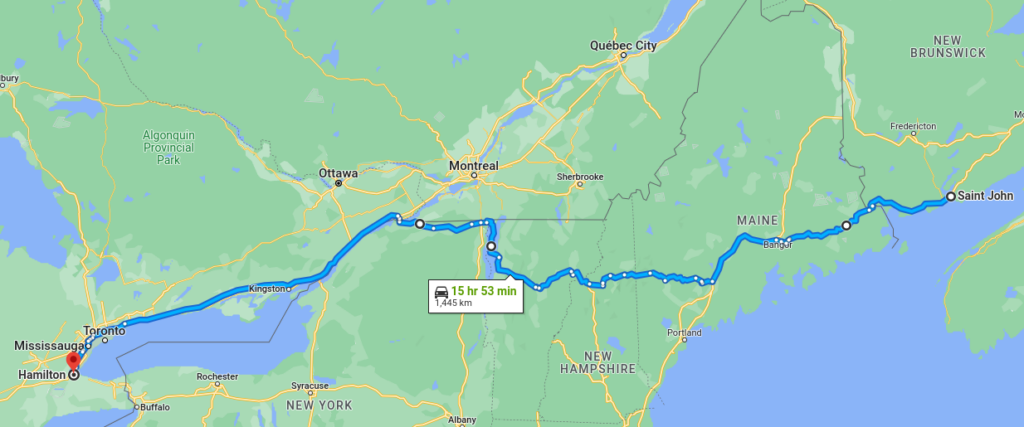
After a quick hour-long drive from Saint John, I entered the United States in Calais, Maine. Despite an occasion where they insisted on searching my vehicle in the past (unpacking all of my belongings that I’d spent hours cramming in, and providing no assistance with packing them back in), I have always found United States border officers to be professional and polite, and this encounter was no different. After not more than a minute or two of talking (including my voluntary presentation of the mandatory COVID-19 vaccination information, in which the border officer seemed thoroughly uninterested), I was allowed to continue, making my way into Maine.
Maine is a state made up primarily of many small towns and lots of forests. The largest city, Portland, counted fewer than 70,000 residents in 2020, yet the state population is almost double that of New Brunswick, despite the state being only slightly larger than its neighbour to the northeast. As I drove through the countryside, even when leaving a town, I rarely went more than a minute or two without seeing a house or business at the side of the highway, and as someone who loves trees and rivers, I can see the appeal of having a countryside home in a place like this. Sadly, I took no photos while I was in Maine: when I am travelling long distances, something has to be really special for me to pull over and take a picture, and in this case, nothing I stumbled upon made me do that. However, I did notice some a common trait of Maine… or perhaps just the United States: signs supporting Donald Trump, either promoting his then-unannounced bid for the 2024 presidency, or accusing Democrats of having “stolen” the election from him. It could be that I was travelling through a particularly Republican part of the state, or simply the fact that Trump supporters are “loud,” but it was surprising to see so much of this.
After several hours in Maine spent following the eastern portion of U.S. Route 2, I started looking for a place to stop in the late afternoon as I was travelling through the western part of the state. It was a Friday after work, I was on vacation, and I would have really enjoyed stopping early, settling into a not-too-shabby motel, and getting a pizza and drink at one of the restaurants in these small, often charming towns perched alongside one of Maine’s many rivers. However, I continued on towards New Hampshire (always saying to myself “Just go a little farther, then you can rest!”), oblivious to the fact that I was passing some of the last places to stay that I would see for a while.
New Hampshire’s arrival came without much fanfare, as the countryside remained unchanged, but at this point I started looking for places to stay. I don’t recall exactly where I started becoming worried, but it seemed that I had underestimated the demand that there would be for motel and hotel rooms, as every hotel or motel that I visited seemed to have no available rooms for the evening.
I continued, soon reaching Vermont. The countryside remained very nice, but the setting sun was worrying me. I continued to look only at low-cost hotels and motels in each town, being systematically informed that there were no rooms available, until I arrived in the city of Montpelier, Vermont’s capital (which also holds the title of the least-populous capital city of any US state). At this point, the sun had set, so I really wanted to stop riding for the night as the clock got closer to 9 PM, but after contacting every hotel and inn in the city, I realised that the only place to stay would have cost over $200 for a single night. An Italian restaurant offered me an opportunity to feed and caffeinate myself, and as I took in some warm food, I considered my options:
- Option 1: Remain in Montpelier and pay over $200 for a place to sleep
- Option 2: Continue a few more hours to Québec, where hotels were well under $100/night
- Option 3: Keep riding until I arrive in Ontario…
Motorcycle riding can be a dangerous activity, and it is important to practice it safely. Despite being a proponent of safe motorcycle riding and having adopted safe habits while actually operating a motorcycle, I have a bad habit of pushing my own limits when it comes to endurance. I had already completed a number of endurance motorcycle challenges, such as the Iron Butt Association’s Border to Border 24-hour ride from Canada to Mexico, so riding from Vermont to Ontario overnight seemed like a very simple way to not spend $200 one a hotel room for a night. I ordered another coffee before leaving the restaurant, as it looked as though I would spend a long night riding slowly to Canada. However, in the end, it was my father who saved me from doing something so foolish, using none other than fatherly guilt and indicating that if I continued riding throughout the night, he’d be awake all night worrying about me. So, I reluctantly checked into the pricey (but very comfortable) hotel, and walked to the local grocery store to pick up some cheap breakfast for the next morning.

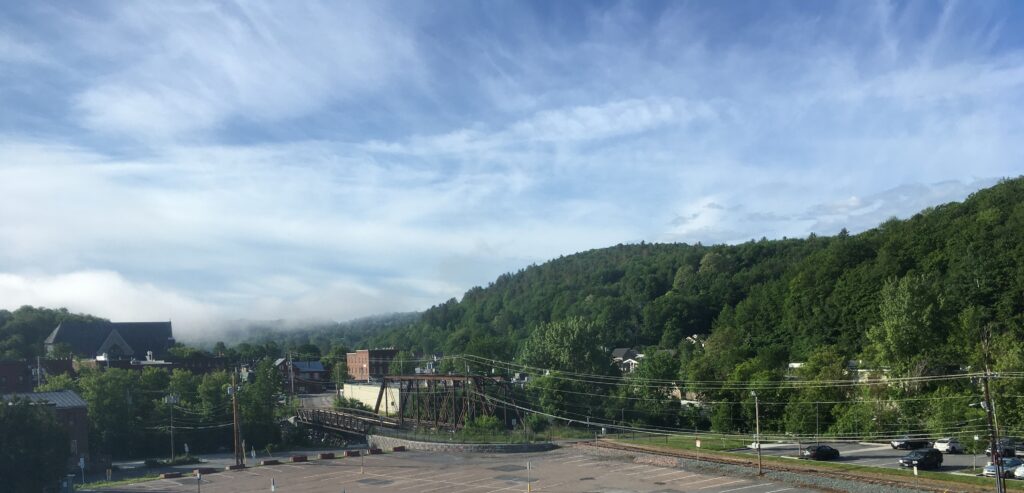
After some excellent sleep in the overpriced hotel, I woke up the next day feeling refreshed and ready to conquer the day’s ride that stood between me and my family. I was fortunate to have enough time to be able to take the slightly more scenic route than what Google Maps suggested to me. I drove west from Montpelier on US Interstate 89, past Burlington (the largest state in Vermont), but instead of continuing up US Interstate 89 all the way to Canada, I crossed a bridge onto the Grand Isle, a large island in the middle of Lake Champlain on which Burlington is perched. Driving north up this island, and continuing onto North Hero Island, was a peaceful experience, with a landscape made up mostly of agricultural land. The pace was slow, the weather was nice, and everything was going alright. As I crossed another bridge from North Hero Island to the western shore of the lake, I entered the state of New York.
Apart from a short visit to Buffalo (right across the border from Canada), I had never spent time in the state of New York before this day. I had heard nice things about upstate New York, and had seen beautiful pictures of places like the Finger Lakes, but this is not the upstate New York that greeted me when I crossed over from the charming islands of Lake Champlain. Instead, I encountered flat farmland punctuated by small towns whose most endearing and popular features seemed to be the Dollar General or Family Dollar stores that inevitably graced their main streets. I think that my most memorable moment in New York was when I left the main highway to take a smaller county road, and was confronted by a barn at the side of the road with “WOMEN FOR TRUMP” painted on the roof in giant block letters. I do try to consider other peoples’ opinions and how they might differ from my own, yet I cannot for the life of me see how any woman could reasonably see value in supporting Donald Trump, unless they were so convinced that he would benefit the country that they were somehow willing to overlook his comments that blatantly insult and objectify women. By the time I got to the border crossing with Cornwall, Ontario, I was happy to be able to leave this particular corner of New York state behind me.
Returning to Canada
Crossing from New York state into Cornwall demonstrates one of the more interesting arrangements on the Canada-US border. The two countries are separated by the St. Lawrence River, but there is an island in the middle of this river, Cornwall Island, that is legally part of Canada, but on which no border post exists – anymore. There are cannabis stores, a Tim Hortons coffee shop, schools, houses… but there is no one to ask you for your passport. The island is part of the Akwesasne Mohawk nation, which is spread across both sides of the border between Canada and the United States, and to which Akwesasne people from both sides of the border are supposed to have unrestricted access. A border post existed on the island until the Canadian government enacted a policy in 2009 requiring all border agents to carry firearms. Following protests to this policy’s application on Cornwall Island by members of the Akwesasne nation, who did not wish to have firearms present on the island due to the potential safety risks of firearm use in their community, the border post was temporarily closed before eventually being moved to the Canadian mainland on the north shore of the St. Lawrence River, making Cornwall Island a part of Canada that is effectively stuck between both the Canadian and American border crossings. Although one can leave the United States and enter Cornwall Island without any administrative formalities, it is illegal to return to the United States without having properly entered Canada (requiring a visit to the north shore of the St. Lawrence River), a policy that resulted in most Americans potentially wanting to purchase Canadian goods from stores on the island simply continuing all the way across the island to shop on the Canadian mainland, and which greatly reduced the value of the business real estate on the island.
At the time, I was unaware of all this, and was simply confused that, after having crossed a bridge from New York state to Cornwall Island, there was no border post. After leaving the island and crossing the bridge towards the mainland, I arrived at the Canadian border post on the north shore of the St. Lawrence River, showed my ID as I normally would, and continued into Ontario.
Within a few minutes, I had reached Highway 401, a major Ontarian freeway that starts in Windsor and continues almost all the way to Montréal. This highway allowed me to easily travel most of the remaining ~570 kilometres between Cornwall and my destination, Port Dover, on the north shore of Lake Erie. I had plenty of sunlight left, and the weather was nice, so I enjoyed a nice, slow ride for the next five hours. Only in Toronto were my good vibes interrupted, when some frustrating traffic distracted me and I missed an exit, but after cursing for a few minutes, I found a new route, and the journey continued. I left Highway 401, following the smaller Highway 6 south to eventually arrive in Port Dover.
After arriving, my father and I went out for dinner at a local restaurant (which, fortunately, had several vegan options – unlike most other restaurants in Port Dover, I later discovered). The first part of crossing Canada towards the west had come to an end. Despite the fact that I rarely miss it when I am away, and that I will probably not live there again on a permanent basis, southwestern Ontario always feels like home when I return there. I was looking forward to spending time with family and friends in the upcoming weeks, before continuing west towards Alberta.

